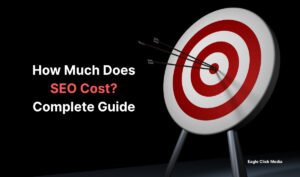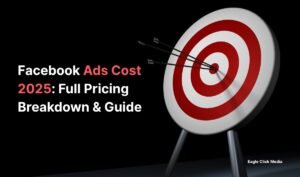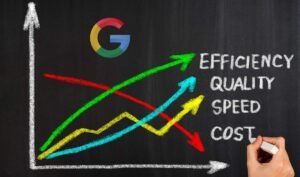Introduction
Reaching the right audience is one of the biggest challenges in digital marketing. Many businesses struggle to find new customers who are genuinely interested in their products or services. This is where Lookalike Audiences come in—a powerful tool that helps businesses expand their reach by targeting people who share similar traits with their existing customers.
At Eagle Click Media, we specialize in data-driven digital marketing strategies, including lookalike audience targeting. In this guide, we’ll explain how lookalike audiences work, their benefits, and the best strategies to use for customer acquisition and ad campaign optimization.

What Are Lookalike Audiences?
A lookalike audience is a group of potential customers who share characteristics, behaviors, and interests with your current audience. These audiences are created using machine learning algorithms that analyze your existing customer data and identify new users with similar traits.
Businesses start by uploading a source audience, such as customer email lists, website visitors, or engaged social media followers. Platforms like Facebook Ads, Google Ads, and LinkedIn Ads then analyze the demographic, behavioral, and interest-based data of this source audience. The algorithm finds people with similar characteristics and creates a new audience for targeting. This allows businesses to run highly targeted ad campaigns to reach potential customers who are more likely to convert.
Benefits of Using Lookalike Audiences
1. Reach High-Quality Prospects
Traditional targeting methods focus on past interactions, but lookalike audiences help businesses find new customers with a high likelihood of conversion.
2. Increase Conversion Rates
Since lookalike audiences are based on real customer data, they tend to have a higher intent to purchase, leading to better ROI on ad spend.
3. Save on Ad Costs
By targeting users who are already similar to your customers, businesses can improve ad relevance, reduce wasted ad spend, and lower cost-per-click (CPC).
4. Improve Lead Generation
Lookalike audiences help brands find qualified leads who are more likely to become long-term customers.
5. Optimize Audience Segmentation
AI-driven audience segmentation allows businesses to test different audience groups and refine marketing campaigns for better performance.
Best Platforms for Lookalike Audiences

Facebook Lookalike Audiences
Facebook uses data from Facebook Pixel, customer lists, and engagement history to create high-quality lookalike audiences. Businesses can adjust the similarity percentage from 1% (most similar) to 10% (broader reach).
Google Ads Similar Audiences
Google analyzes search behavior and helps brands reach users with similar intent and search habits. This works well with Google Display Network and YouTube Ads.
LinkedIn Lookalike Audiences
LinkedIn is ideal for B2B marketing, helping businesses target professionals based on job roles, industries, and company size.
TikTok Lookalike Audiences
TikTok uses AI-driven ad platforms to find engaged users, making it ideal for brands targeting younger demographics.

How to Create a Lookalike Audience
Step 1: Define Your Source Audience
Choose a high-value customer list, such as recent buyers, repeat customers, or high-engagement users. The better the source audience, the better the lookalike results.
Step 2: Select the Right Audience Size
Smaller audiences (1-2%) offer more precision, while larger audiences (5-10%) provide broader reach but may be less relevant.
Step 3: Upload Your Source Data
Use platforms like Facebook Business Manager, Google Ads, or LinkedIn Ads to upload your source audience. Ensure the data is clean and well-segmented.
Step 4: Launch & Optimize Your Campaign
Create personalized ad creatives tailored to your new audience. A/B test different ad formats and messaging, then monitor performance and adjust targeting as needed.
Common Mistakes to Avoid
1. Using a Weak Source Audience
If your source audience is too broad or unqualified, the lookalike audience won’t be effective.
2. Not Testing Different Audience Sizes
Experiment with smaller and larger percentages to find the best-performing audience for your campaign.
3. Overlapping Audiences
Make sure your custom audience and lookalike audience don’t overlap to prevent competing ads from driving up costs.
4. Ignoring Performance Metrics
Regularly analyze conversion rates, CPC, and engagement metrics to optimize campaigns and improve ROI.

Future Trends in Lookalike Audiences
As AI continues to evolve, lookalike audience targeting will become even more precise. AI-driven predictive analytics will help businesses identify potential customers before they even show interest. Real-time audience updates will allow businesses to adapt to behavioral changes instantly. Additionally, improved integration with privacy-first advertising will ensure compliance with new data regulations.
At Eagle Click Media, we stay ahead of these trends to help businesses maximize their marketing efforts.
Conclusion
Lookalike audiences are a powerful tool for finding new customers, improving ad performance, and maximizing ROI. By leveraging AI-driven data analysis, businesses can scale their digital marketing efforts efficiently.
If you want to implement lookalike audience targeting for your business, contact Eagle Click Media today for expert digital marketing solutions.
📞 Get in touch now and start reaching the right audience for your business!
FAQs
1. What is a lookalike audience in digital marketing?
A lookalike audience is a group of people who share similar characteristics with your existing customers. It helps businesses expand their reach and target high-potential prospects.
2. How does Facebook create lookalike audiences?
Facebook analyzes data from your source audience (e.g., website visitors, customer lists, or engagement data) and uses machine learning to find users with similar behaviors and interests.
3. Are lookalike audiences better than interest-based targeting?
Lookalike audiences are often more effective than interest-based targeting because they use real customer data instead of general assumptions.
4. What’s the best audience size for lookalike targeting?
A 1-2% audience size offers the most precision, while a larger 5-10% audience provides more reach but may be less relevant.
5. How can I optimize my lookalike audience campaigns?
Use high-quality source data, test different audience sizes, refine your ad creatives, and analyze campaign metrics regularly for better results.
By leveraging lookalike audiences, businesses can improve their targeting strategy, reduce ad costs, and increase conversions. Contact Eagle Click Media today to learn more!





